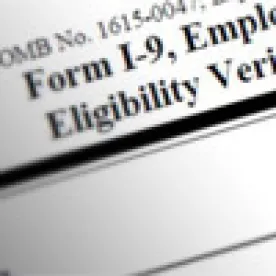As part of his first-week initiatives, President Trump turned his focus toward immigration. These initiatives included dramatically expanding the resources of the U.S. Department of Homeland Security’s Immigration and Customs Enforcement (ICE) agency. Specifically, the Trump administration authorized the hiring of 10,000 ICE agents across the United States. This increase in the number of ICE officers will have a direct impact on employers as it relates to I-9 compliance and ICE audits of Forms I-9. For example, it is anticipated that ICE Homeland Security Investigations (HSI) audits will increase to around 3,000 in 2017, tripling the number of audits performed in recent years.
Why Care About I-9 Compliance?
There is potential civil and criminal liability associated with the completion of the Form I-9. For example, each paperwork violation—regardless of whether the individual completing the Form I-9 is a U.S. Citizen or alien—exposes an employer to fines ranging from $216 to $2,156 for each violation. In addition to civil liability penalties, ICE can pursue criminal liability penalties. The following are the legal theories that ICE may pursue to bring criminal charges:
-
Harboring, encouraging, or inducing an alien to remain in the United States in violation of the law. If performed for commercial advantage, an individual could face up to 10 years per count in prison. In addition, company assets involved in the illegal activity could be subject to civil forfeiture.
-
Knowingly hiring at least 10 unauthorized individuals within a 12-month period with actual knowledge that they were not authorized to work and that they were brought to the United States in violation of the law. This violation carries a penalty of up to five years in prison.
-
Impeding, impairing, or obstructing lawful government functions of the Internal Revenue Service (IRS) or U.S. Social Security Administration. This offense is punishable by up to five years in prison.
-
Making material misrepresentations on a Form I-9. A conviction is punishable by up to five years in prison.
-
Engaging in a pattern or practice of hiring, recruiting, or referring for a fee unauthorized aliens. This violation carries a possible term of imprisonment of up to six months and fines of up to $3,000 for each unauthorized alien.
If I Hire Union Labor, Does That Shield Me From Liability?
No. Form I-9 rules allow an employer who hires labor pursuant to a multi-employer bargaining unit to rely on and use a Form I-9 properly completed within the past three years by another employer within the same association. When doing so, an employer is protected from civil liability associated with the Form I-9. But when the Form I-9 is not properly completed, the subsequent hiring employer assumes civil liability associated with the errors in those forms.
In addition, the employer assumes criminal liability associated with knowingly hiring someone who is not authorized to work in the United States. There is a reasonable presumption that an employer knew the person was unauthorized when it hires someone who is not authorized to work. As a result, employers hiring union workers should always review previously completed I‑9s to ensure compliance with immigration laws.
Employers are presented with a choice when reviewing union labor hiring practices. On one hand, employers can use earlier completed Forms I-9, but they need to verify that these forms were properly completed to avoid liability. Doing so, however, will decrease the administrative burden associated with having to run E-Verify queries on new employees. On the other hand, employers can treat union hires as “new hires” and complete new Forms I-9, and then run E-Verify queries if required. Doing so may increase the burdens associated with a collective bargaining agreement, but it will better protect the employer from liability associated with improperly completed Forms I-9.
Do I Need to Ensure I-9 Compliance for My Contractors?
In general, employers are not required to complete and retain Forms I-9 for their independent contractors. But the definition of an independent contractor is more restrictive in the immigration context than some employers understand. In fact, ICE takes a narrower reading of independent contractors than the IRS. As a result, individuals who may be considered independent contractors for tax purposes would be considered employees for immigration purposes requiring the completion of Forms I-9.
An exception to the independent contractor rule is that prime contractors are required to ensure their subcontractors use E-Verify when:
-
the prime contract includes a Federal Acquisition Regulation (FAR) E-Verify clause;
-
the subcontract is for commercial or noncommercial services or construction;
-
the subcontract has a value of more than $3,000; and
-
the subcontract includes work performed in the United States.
In general, subcontractors who do not provide any services and only provide supplies are not subject to the E-Verify federal contractor rule.
Prime contractors may be subject to fines and penalties if they knowingly continue to work with subcontractors who are in violation of the E-Verify requirement. While prime contractors are not responsible for verifying their subcontractors’ individual employees, they must ensure that all covered subcontracts at every tier incorporate FAR clause 52.222-54 – Employment Eligibility Verification.
How Do I Clean Up My Forms I-9?
Employers would do well to be consistent and transparent when conducting Form I-9 internal audits. When errors are found in Forms I-9, it is not helpful to discard or apply correction fluid to the forms. Instead, corrections are best made by crossing out, dating, and initialing the correction on the Form I-9. Common errors found in Forms I‑9 include the following:
-
the employee failed to make a selection in the attestation section of Section 1;
-
the employee failed to date his or her signature in Section 1;
-
the employer failed to write the employee’s name at the top of Section 2;
-
the employer failed to insert the issuing authority for the verification documents;
-
the employer failed to insert the first day of employment in Section 2; or
-
the employer failed to sign and date Section 2.
What if I Forgot to Create an E-Verify Query for an Employee?
If an employer discovers through an internal audit that it inadvertently failed to create an E‑Verify case for employees hired after the employer enrolled in E‑Verify, the employer should bring itself into compliance and create a case for the employee. But if the employer did not use the system as a business practice at the time, it should not go back and create cases for employees hired during the time that there was deliberate non-use of E-Verify. It would also be wise to complete a signed and dated explanation of the corrective action taken and include that explanation with the employee’s I-9 documentation, whether that documentation is stored in physical or electronic files.





 />i
/>i

